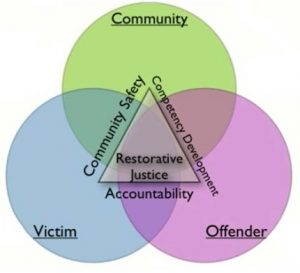Both John Rosiak and Steven C. Teske believe that police on school campuses, referred to as school resource officers (SROs), are a growing problem, and one which disproportionally affects students of color. Rosiak, a juvenile-court judge, explains that while SROs are put intended to be for students’ protection, the result is the criminalization of students of color for small offenses. Strict policies and discipline lead to more court referrals, and subsequently lower graduation rates and higher crime rates (Rosiak, para. 6). These SROs are not doing their jobs of keeping students safe, and both Rosiak and Teske have suggestions for creating a better environment for students in schools with SROs.

http://dhss.alaska.gov/djj/Pages/GeneralInfo/RJ.aspx
Teske is an educator who has worked closely with law-enforcement in schools, and through this he has come up with ideas for how to ensure a better relationship between students of color and SROs. He believes that five things must be considered (Teske, para. 4-11):
- Defining Roles—SROs are not in charge of school rules and discipline, and so they should not be the ones to engage in that type of behavior with students.
- Selection of Officers—deciding who the SROs are must be a more in-depth process. Motivations and expectation should be taken into account, and the school and community can assist in this selection.
- Officer Preparation—SROs “training must be thorough, up-to-date, and go beyond standard training as a law-enforcement officer” (Teske, para. 8). More must be done to help SROs understand and work better with students. Teske and Rosiak both suggest special training on adolescent development, which can help SROs understand the thought patterns of youth so they can prevent escalating situations (Rosiak, para. 12).
- Defining Policy—School policies need to outline exactly what the role of SROs is so that any confusion is eliminated. Rosiak also suggests this, explaining that these policies help prevent SROs from becoming “disciplinarians” (Rosiak, para. 10).
- Community Engagement—School and law-enforcement need to reach out and make connections with community partners who also want to keep schools safe.
In addition to these ideas, Rosiak also suggests having “trauma-informed approaches to discipline,” which takes into account the possibilities of dealing with traumatized students and their behaviors (Rosiak, para. 14). Many different things must be taken into account when deciding to include SROs on school campus, especially when there are high numbers of students of color. Everyone in the community need to be informed, prepared, and willing to work with students amicably so that the school environment is less hostile for minority students.
Teske, S. (2017). Why this juvenile-court judge worries about school resource officers.
EdWeek.org. Retrieved from
https://www.edweek.org/ew/articles/2017/10/11/why-this-juvenile-court-judge-
worries-about-school.html?qs=resource+officers
Rosiak, J. (2017). 5 things to consider before posting cops in schools. EdWeek.org.
Retrieved from https://www.edweek.org/ew/articles/2017/10/11/5-things-to-
consider-before-posting-cops.html?qs=resource+officers
